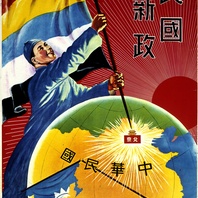
Item
Minguo xinzheng (New government for the Republic)
This poster was almost certainly produced to coincide with the founding of the PGROC in December 1937. The visual trope of the rising sun and city gates of Beijing emitting light are clearly reminiscent of Manchukuo propaganda. Note also the references to a tattered Chinese Nationalist Party (KMT) flag, with its “white sun” emblem. The replacement of this flag with the “five coloured flag ” (wuseqi), which was revived by the PGROC in 1937, was indicative of a general approach under this administration to discredit Nationalist ideologies in favour of more conservative, Confucian ideas. Note also the rather ambitious designs that this regime had on the rest of China (the man is planting his flag on China as a whole, rather than the patchwork of territory in north China over which the PGROC actually ruled).
Read More
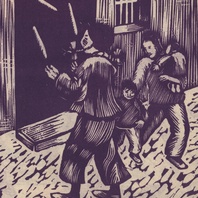
Item
Fengyang guniang (Maidens of Fengyang)
This woodcut, by an artist called Fang Wenxing, was reproduced in Zhonghua huabao (Chinese Pictorial) 1.4 (November 1943). The importance of the muke (woodcut) form to artistic practice in occupied China has been almost entirely overlooked in the literature. The muke form has hitherto been associated with the art of resistance in China, despite being an important part of “occupation” visual cultures as well.
Read More
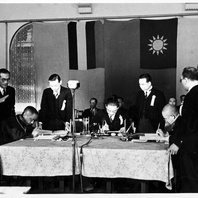
Item
Signing of Japan-Manchukuo-China Joint Declaration
Flanked by courtiers, Zang Shiyi, the Manchukuo ambassador to the RNG (seated to the left), Noboyuki Abe, Japanese ambassador to the RNG (seated to the right), and Wang Jingwei (seated in the centre) sign the Japan-Manchukuo-China Joint Declaration on 30 November 1940, through which RNG China recognised Manchukuo. The Declaration was attached to the Sino-Japanese Basic Treaty, through which Japan formally recognised the RNG. Both documents were signed within the main RNG government compound in Nanjing. The flags of Japan, China and Manchukuo are on the wall behind the men.
Read More

Essay
Bodies of Occupation: Conversation with Hyunhye (Angela) Seo
This conversation with artist Hyunhye (Angela) Seo will explore how colonialism and occupation not only shape the occupied culture, but how that culture, adapts, inherits and responds, and the melding of native/original culture and coloniser culture into something familiar yet new. Still from the video It Comes out as a Joke (Xiu Xiu), directed by Angela Seo and Anna Lian Tes (2019), courtesy of the artist Participants Hyunhye (Angela) Seo is an artist exploring experimental composition and expression of sound and its manifestations within space and body. She is a member of the musical group Xiu Xiu, in which she extends the band’s visual themes to immigrant diaspora, post-colonial spirituality and ritualism, and exotification/fetishisation via videos that have been featured in film festivals around the world. She has performed in collaboration with various artists spanning the visual and performance world, including with Danh Vo (“Metal” at The Kitchen, and “Deforms the Unborn” at the Guggenheim NYC), and the Berlin-based Cheap Collective (featuring Vaginal Davis, Susanne Sachsse and Marc Siegel). Recently, her solo album, Strands, explores abstract soundscapes built with processed percussion, improvisational piano, and dark ambient material. Her sound installations in relation to this work create an immersive territory that compels the listener to question how they carry the immediate and lingering impact of sound (her website). Russ Skelchy is an interdisciplinary scholar specialising in the popular musics of Indonesia and Malaysia. He received his PhD in Ethnomusicology (2015) and MA in Southeast Asian Studies (2010) from the University of California, Riverside. His research interests include multiracial studies, sound studies, popular music (sub)cultures, decolonisation and gender. He was a recipient of a Fulbright US Scholar grant (2017-2018), Fulbright Institute for International Education Fellowship (2011-2012) and the University of California Pacific Rim Research Program Fellowship (2011-2012), and he was an ERC Research Fellow on the COTCA Project from 2017 to 2020. His work has been published in the Journal of Popular Music Studies, South East Asia Research, Sound Studies and various other international journals. Still from the video Pumpkin Attack on Mommy and Daddy (Xiu Xiu), directed by Angela Seo and Anna Lies Tan (2019), courtesy of the artist.
Read More
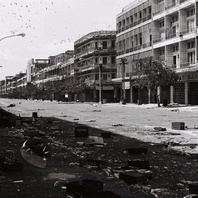
Featured Item
Empty Avenue, Phnom Penh
This photograph is part of the collection held by the Agence Khmère de Presse (AKP) and Cambodia’s Ministry of Information. This collection, which documents the early years of the People’s Republic of Kampuchea as photographed by the Vietnamese and a small team of Cambodian photographers, has not yet been classified or indexed.
Read More
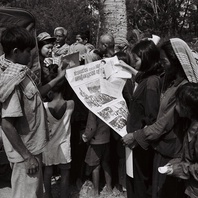
Featured Item
Villagers looking at a poster
This (probably staged) photograph shows a group of villagers looking at an illustrated poster about the Kampuchea United Front for National Salvation (KUFNS, also known as FUNSK) [Front or Renakse]. It is part of a series that describes the same group of villagers and soldiers. This photograph is part of the collection held by the Agence Khmère de Presse (AKP) and Cambodia’s Ministry of Information. This collection, which documents the early years of the People’s Republic of Kampuchea as photographed by the Vietnamese and a small team of Cambodian photographers, has not yet been classified or indexed.
Read More
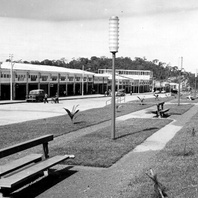
Featured Item
Commercial street in Sihanoukville
This unattributed photograph shows a commercial street in Sihanoukville town centre in the mid 1960s, with one side of the street having a promenade with benches and lampposts, and shops on the opposite side, under an arcade. The photograph is part of the collection that was donated to the National Archives of Cambodia from the Library of the Royal University of Fine Arts by Darryl Collins and Helen Grant Ross in 2003. The collection was used by Collins and Ross for their research into urbanisation. The images were probably originally used to mount the Sangkum Reastr Niyum Permanent Exhibition at the Exhibition Hall, Bassac area, Phnom Penh.
Read More
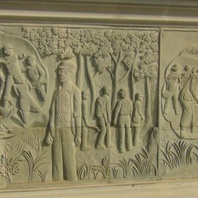
Item
Win-Win Monument bas-relief
This photograph provides a view of bas-relief on the 117-metre-long engraved base of the Win-Win Monument. It depicts the defection to Vietnam of the then Khmer Rouge officer Hun Sen in June 1977. One sees Hun Sen (dressed in Khmer Rouge garb) considering what may happen to him and his group of defectors (being killed) if they are caught by the Khmer Rouge. It also shows Hun Sen thinking about his wife who he left behind. The Win-Win Monument complex – photographed here in January 2020 – was inaugurated in December 2018 to mark the twentieth anniversary of the end of the post-Democratic Kampuchea civil war, with the final defection of the remaining Khmer Rouge factions, thanks to the DIFID policy (“Divide, Isolate, Finish, Integrate, Develop”) also known as the “Win Win” policy of Prime Minister Hun Sen.
Read More
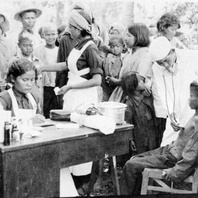
Featured Item
Medical team treating children
This unattributed photograph, showing a medical team treating children, was featured in the publication (French and English versions) entitled The People’s Republic of Kampuchea (1979). This photograph is part of the collection held by the Agence Khmère de Presse (AKP) and Cambodia’s Ministry of Information. This collection, which documents the early years of the People’s Republic of Kampuchea as photographed by the Vietnamese and a small team of Cambodian photographers, has not yet been classified or indexed.
Read More
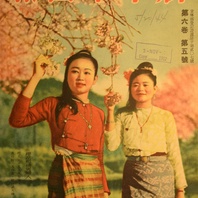
Item
Xin Zhonghua huabao (New China Pictorial) cover, May 1944
This cover image from the Xin Zhonghua huabao (New China Pictorial) 6.5 (May 1944) shows a photograph of two unnamed Burmese women. The New China Pictorial was a bilingual (Chinese-English) magazine published from 1939 through 1944 in Shanghai by the occupation journalist Wu Linzhi for distribution in China and throughout Southeast Asia. This magazine employed cover images of women from areas of Southeast Asia that had been conquered by Japan with increasing regularity over the course of 1943 and 1944, having previously focused on Chinese film celebrities.
Read More
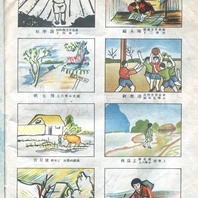
Item
Ertong zuopin (works by children), II
This is a selection of images (most being pencil drawings) contributed to the magazine Ertong huakan (Children’s Pictorial) 9.10 (April 1941) by readers. The images offer a fascinating insight into the ways in which official ideas about the appearance of occupied China were reflected in the artwork of Chinese school children living in the RNG capital. Note the references to dawn, for example, the depictions of Japanese people, and the idyllic images of the Chinese countryside included in some of the drawings. Basketball remained a politically acceptable sport in occupied Nanjing despite its American provenance.